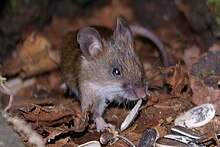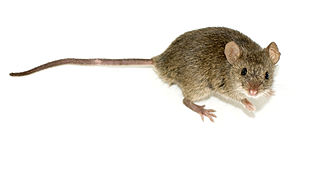
A mouse is a small rodent. Characteristically, mice are known to have a pointed snout, small rounded ears, a body-length scaly tail, and a high breeding rate. The best known mouse species is the common house mouse. Mice are also popular as pets. In some places, certain kinds of field mice are locally common. They are known to invade homes for food and shelter.

The yellow-necked mouse, also called yellow-necked field mouse, yellow-necked wood mouse, and South China field mouse, is closely related to the wood mouse, with which it was long confused. It was only recognised as a separate species in 1894. It differs in its band of yellow fur around the neck and in having slightly larger ears and usually being slightly larger overall. Around 100 mm in length, it can climb trees and sometimes overwinters in houses. It is found mostly in mountainous areas of southern Europe, but extends north into parts of Scandinavia and Britain. It facilitates the spread of tick-borne encephalitis to humans and is a reservoir species for the Dobrava virus, a hantavirus that is responsible for causing haemorrhagic fever with renal syndrome.
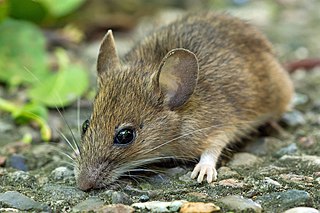
The wood mouse is a murid rodent native to Europe and northwestern Africa. It is closely related to the yellow-necked mouse but differs in that it has no band of yellow fur around the neck, has slightly smaller ears, and is usually slightly smaller overall: around 90 mm (3.54 in) in length and 23 g in weight. It is found across most of Europe and is a very common and widespread species, is commensal with people and is sometimes considered a pest. Other common names are long-tailed field mouse, field mouse, common field mouse, and European wood mouse. This species is a known potential carrier of the Dobrava sequence of hantavirus which affects humans and may pose serious risks to human health.

Apodemus is a genus of Muridae. The name is unrelated to that of the Mus genus, instead being derived from the Greek ἀπό-δημος.

The striped field mouse is a rodent in the family Muridae. The range of this species stretches from Eastern Europe to Eastern Asia.

The alpine field mouse is a species of rodent in the family Muridae. It is found in Austria, France, Italy, Germany, and Switzerland.
Chevrier's field mouse is a species of rodent in the family Muridae. It is found only in China.
The Himalayan field mouse is a species of rodent in the family Muridae. It is endemic to Nepal.
The Caucasus field mouse is a species of rodent in the family Muridae.
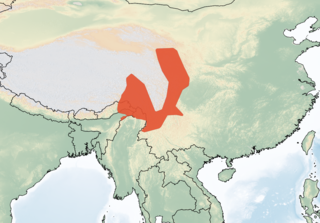
The Sichuan field mouse is a species of rodent in the family Muridae. It is found in Qinghai and Sichuan provinces of China, and in India and Burma.
The Black Sea field mouse is a species of rodent in the family Muridae. It is found in Armenia, Azerbaijan, Georgia, possibly Iran, Iraq, Russian Federation, and Turkey.

The Taiwan field mouse, also called Formosan wood mouse, is a species of rodent in the family Muridae. It is found only in Taiwan.

The large Japanese field mouse is a nocturnal species of rodent in the family Muridae. It is endemic to Japan.

The Japanese dormouse is a species of rodent in the family Gliridae endemic to Japan. It is the only extant species within the genus Glirulus. Its natural habitat is temperate forests. In Japanese, it is called yamane. Among dormice, it has the special ability of running at great speed upside down, suspended from branches. Its main food is fruit, insects, berries, nuts, and even flowers. It tends to inhabit arboreal nesting sites to avoid interspecific competition with the small Japanese field mouse because of their sympatric relationship.

The St Kilda field mouse is a subspecies of the wood mouse that is endemic to the Scottish archipelago of St Kilda, the island 40 miles (64 km) west of Benbecula in the Outer Hebrides, and 100 miles (160 km) from mainland Scotland. Unique to the islands, the mouse is believed to have arrived on the boats of Viking settlers more than a millennium ago. It is not to be confused with the St Kilda house mouse, a subspecies of the house mouse which is now extinct.

The northern grasshopper mouse is a North American carnivorous rodent of the family Cricetidae. It ranges over much of the western part of the continent, from southern Saskatchewan and central Washington to Tamaulipas in northeast Mexico.
Bartonella japonica is a species of bacteria in the genus Bartonella. A strain of this species was originally isolated from the blood of a small Japanese field mouse.

Rhagamys is an extinct genus of rodents in the subfamily Murinae, the Old World mice and rats. The genus was established by the Swiss zoologist Charles Immanuel Forsyth Major to accommodate Rhagamys orthodon, which is the only species in the genus. It was endemic to the Mediterranean islands of Corsica and Sardinia, descending from Rhagapodemus, which had colonised the islands around 3.6 million years ago. Its closest living relatives are of the genus Apodemus, which includes the field and wood mice.
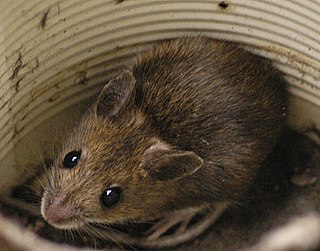
Apodemini is a tribe of muroid rodents in the subfamily Murinae. It contains two extant genera, one found throughout Eurasia and the other endemic to the Ryukyu Islands. Several fossil genera are also known from throughout Eurasia, including one large species (Rhagamys) that persisted on Sardinia and Corsica up until at least the first millennium BC, when it was likely wiped out by human activity.
